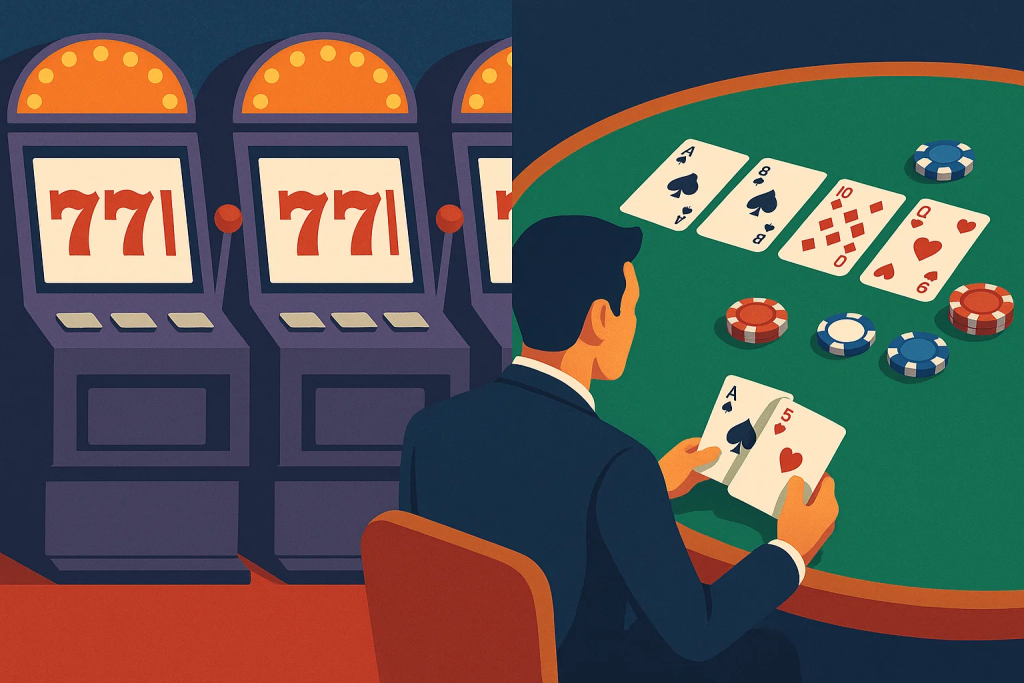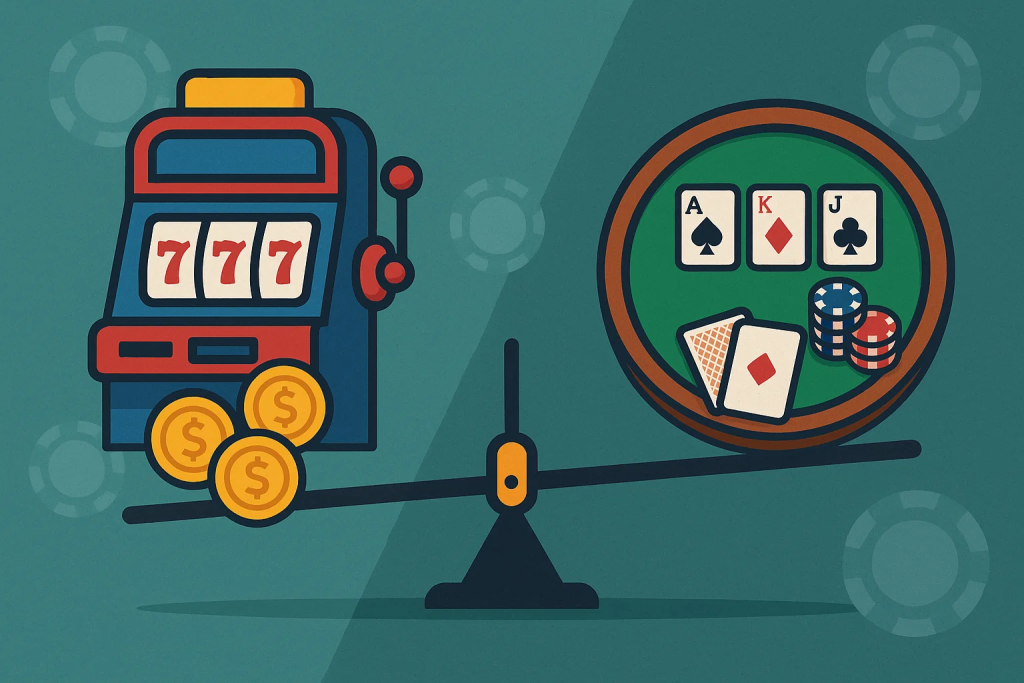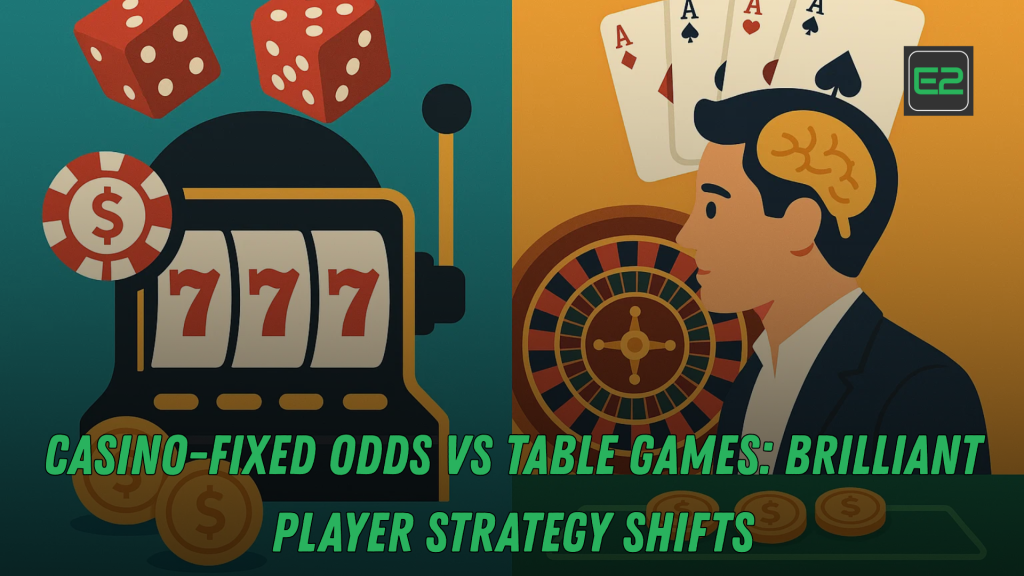Table of Contents
Executive Summary
In the last decade, player behavior in casinos—both land-based and online—has shifted noticeably. Fixed-odds games (like slots, keno, and instant-win titles) have surged thanks to speed, simplicity, and slick UX, while table games (blackjack, roulette, baccarat, craps, poker) still draw players who want skill-based edges, social energy, and slower, more strategic play. This article explains the differences between fixed-odds and table games, why strategies are changing, and how to optimize your results—no matter which side of the felt you prefer.

What Are “Fixed-Odds” Casino Games?
Fixed-odds games are titles where every wager’s payout is predetermined by a paytable or probability model. You place a bet, an outcome is randomly generated, and the result either matches a listed payoff or doesn’t—there’s no ongoing decision tree after the bet is made.
Common fixed-odds formats:
- Slots & Video Slots (including Megaways, hold-and-spin, and progressive jackpots)
- Instant-Win / Crash / Mines / Plinko-style games in online casinos
- Keno & Scratch Cards
- Virtual sports & number draws
Core characteristics:
- Pace: Rapid—hundreds of decisions per hour are possible.
- Agency: Minimal after the bet is placed; decisions mostly happen before the spin (bet size, lines, volatility setting if available).
- Return to Player (RTP): Published as a percentage (e.g., 96%). In practice, results vary widely in the short run due to variance.
- Volatility: Ranges from low (frequent small wins) to extreme (rare massive hits).
- House Edge: Baked into the math and unchangeable via “strategy” beyond game and stake selection.
What Are Table Games?
Table games involve a dealer (human or live-dealer streaming) and often allow strategic decisions after the initial wager.
Core table games:
- Blackjack: Make decisions—hit, stand, split, double—against a dealer, with mathematically provable “basic strategy.”
- Roulette: Multiple bet types; house edge depends on wheel (European vs American) and side bets.
- Baccarat: Banker vs Player bets with simple decisions but nuanced bankroll strategy.
- Craps: A matrix of wagers with dramatically different house edges; table etiquette and momentum matter.
- Casino Poker Variants: Three Card, Caribbean Stud, Ultimate Texas Hold’em—fixed paytables but with player decisions and optional side bets.
Core characteristics:
- Pace: Moderate to slow; fewer decisions per hour than slots.
- Agency: Meaningful; decisions can reduce house edge within narrow bounds.
- Transparency: Odds are visible or widely published; optimal strategies are well known.
- Social Experience: Energy, rituals, and camaraderie add to the appeal.
Fixed-Odds vs Table Games: The Mathematical Differences
House Edge & RTP (Return to Player)
- Fixed-Odds: The RTP is the inverse of the house edge (e.g., 96% RTP ≈ 4% house edge). You cannot change it mid-game; your only levers are which game and what bet size/volatility you choose.
- Table Games: The house edge can effectively shrink when you make optimal decisions. For example, using basic strategy in blackjack lowers the edge; choosing European roulette (single zero) instead of American (double zero) improves your expectation; craps pass line with odds is far better than proposition bets.
Volatility & Bankroll Swings
- Fixed-Odds: Volatility is the star. High-volatility slots can burn a bankroll fast or deliver life-changing hits. Short-term results are dominated by streakiness.
- Table Games: Volatility exists but is often gentler with core bets (e.g., baccarat banker, craps pass line). Side bets reintroduce slot-like volatility.
Decision Density
- Fixed-Odds: 95% of your “strategy” happens before you press spin.
- Table Games: Decision density is high during play (especially blackjack and some poker variants). Your skill affects results over the long run.
Why Player Strategy Is Shifting
1) Speed & Dopamine Loops
Modern casino audiences are used to fast feedback (video games, mobile apps, short-form content). Fixed-odds games offer rapid cycles, achievements, bonus rounds, and audiovisual “wins” that keep the session exciting even when net returns are negative.
Strategy implication: Players prioritize session entertainment per minute—not just expected value.
2) UX Innovation & Theme Depth
Slots and instant-win games have become multimedia experiences. Personalized missions, tiered jackpots, and sticky bonuses encourage longer sessions.
Strategy implication: Choice expands beyond “which game pays more” to questions like “Which mechanics and volatility profile fit my bankroll and time budget?”
3) Online Growth & Live-Dealer Bridge
Online casinos exploded in availability and convenience. Live-dealer tables act as a bridge: you get table-game strategy and social elements without traveling to a pit.
Strategy implication: Players diversify: fixed-odds for quick sessions, live dealer for slower, social nights.
4) Transparency & Education
Strategy resources for blackjack, craps, baccarat, and roulette are widely available, shrinking the “mystique.” Meanwhile, fixed-odds games publish RTP bands, and some display volatility ratings.
Strategy implication: Informed choice—players are better at picking the right product for their goals (fun, comps, or stretching bankroll).
How to Choose Between Fixed-Odds and Table Games (Based on Your Goals)
Goal A: Entertainment Per Minute
- Pick: Fixed-odds (slots, crash, instant-win).
- Why: Constant engagement, bonus games, streams of micro-outcomes.
- How to optimize: Choose volatility that fits your budget (low to medium for longer playtime; high if you’re hunting big hits).
Goal B: Lowest House Edge / Best Long-Run Expectation
- Pick: Table games with optimal rules and strategy.
- Shortlist:
- Blackjack (favorable rules + basic strategy)
- Baccarat (banker bet)
- Craps (pass line + max odds; avoid props)
- European Roulette over American (single zero vs double zero)
- How to optimize: Study basic strategy charts, table rules, and side-bet risk.
Goal C: Social Energy & Ritual
- Pick: Table games in a lively pit or live-dealer online.
- Why: Shared wins, table superstitions, dice calls—these are crowd-powered experiences.
- How to optimize: Learn etiquette (especially craps), choose lower-edge core bets, and set clear win/loss limits.
Goal D: Comp Value & Tier Climbing
- Pick: Depends on the loyalty program’s earning model.
- Why: Some programs award points per dollar wagered, not per house edge; fast-paced fixed-odds can accelerate accrual.
- How to optimize: Read the comp rules; if points are rate-based, a low-denomination, high-volume fixed-odds strategy might maximize tier progress (but mind the expected loss per hour).
Bankroll Management That Actually Works (For Both Categories)
Step 1: Define Session Objectives
- Time-based goal: “I want to play for 2 hours.”
- Hit-based goal: “I want a shot at a 100x win.”
- Edge-based goal: “I want the lowest theoretical loss.”
Step 2: Set Hard Limits
- Loss limit: A number you won’t cross (e.g., 2%–5% of monthly discretionary budget per session).
- Win goal: Either a fixed amount or a multiple of buy-in (e.g., 50% up). Lock in profit by walking away or pocketing half (the “pocket trick”).
Step 3: Match Bet Size to Volatility & Pace
- Fixed-odds: The faster the game and higher the volatility, the smaller each spin should be to sustain your session length.
- Table games: Favor core, low-edge bets to control variance. If you use progressions (e.g., pressing in craps after a hit), cap the number of presses.
Step 4: Use Stop-Loss and Stop-Win Tools
- Pre-commit to a stop-loss and stop-win number. If your platform allows, use reality checks, cool-offs, or time reminders.
Step 5: Track Your Play
- Keep a simple log (date, game, stake, session length, result, feelings). Pattern awareness improves decisions more than any mythic “system.”

Practical Strategies for Fixed-Odds Players
1) Choose Volatility Intentionally
- Low/Medium Volatility: Steady small wins, long sessions, fewer dry spells—best for casual budgets.
- High/Extreme Volatility: Long droughts with potential for big features—best for thrill-seekers with a disciplined stop-loss.
2) Understand RTP Bands
Some online titles offer multiple RTP configurations to operators. A game listed at “92%–96%” might be set anywhere in that range.
- Tip: Check the info screen. If multiple versions exist, prefer higher-RTP variants.
3) Smart Bonus Play
- Read Wagering Terms: Know contribution rates (slots often 100%, table games less), max bet rules, and withdrawal conditions.
- Prioritize Clearable Promos: Time your session length to realistically finish wagering without chasing.
4) Bet Sizing for Longevity
- Rule of Thumb: For a 2-hour session on medium-volatility slots, consider 200–400 base bets (e.g., $0.50–$1 on a $100 budget). Adjust up/down by volatility.
5) Progressive Jackpots ≠ Everyday Value
- The base RTP may be lower, with value concentrated in rare jackpots. If you’re bankroll-constrained, non-progressives with higher base RTP can stretch playtime.
Practical Strategies for Table-Game Players
Blackjack: Always Start with Basic Strategy
- Action: Learn a chart for your table’s rules (number of decks, dealer hits/stands on soft 17, double after split, surrender).
- Avoid: Insurance (unless you’re an advantage player counting cards).
- Bankroll Tip: Flat bet or modest bet spreads; avoid emotional chasing.
Roulette: Wheel Selection & Bet Discipline
- Pick: European or single-zero wheels when available.
- Avoid: Long-shot side bets with steep edges; systems like Martingale don’t change EV and risk bankroll ruin.
Baccarat: Banker Is (Usually) Best
- Default Bet: Banker—often the lowest house edge after commission.
- Avoid: Tie bet and exotic side bets unless you accept higher variance and house edge for fun.
Craps: Love the Odds, Lose the Props
- Core: Pass Line (or Don’t Pass) + Max Odds; place 6/8; consider Come bets with odds.
- Avoid: Center table proposition bets; they’re entertaining but expensive in the long run.
Casino Poker Variants: Know the Fold Points
- Action: Study the optimal raise/check/fold thresholds per variant.
- Side Bets: Fun but volatile—treat them as entertainment spend, not strategy.
The Psychology Behind the Shift
Variable Rewards & Perceived Control
- Fixed-Odds: Variable rewards (bonuses, near-misses) can feel like progress. Players enjoy the “just one more spin” rhythm.
- Table Games: Perceived control comes from making decisions and reading the table. The win feels “earned,” which many players value.
Social vs Solo Modes
- Fixed-Odds: Suits solo play, mobile sessions, or casual multitasking.
- Table Games: Ritual and camaraderie—especially in craps—boost enjoyment and session duration, even for low-stakes players.
Time Illusion & Cost Per Hour
- Faster cycles can compress time perception. A key skill is matching pace to budget to avoid overspending in short windows.
Live Dealer: The Middle Path
Live-dealer games merge table-game strategy with the convenience of online play. They also slow the pace, which can be kinder to your bankroll. If you’re moving from slots to tables, live dealer is a great on-ramp:
- Pros: Real dealers, clearer odds, slower decision tempo.
- Cons: Tipping/side bets temptations, table minimums may be higher than RNG tables.
Strategy tip: Start at low-limit blackjack or baccarat. Use basic strategy cards (many platforms allow one open on screen).
Example Session Plans (Copy & Use)
A) Fixed-Odds “Entertainment First” Plan (60–90 minutes)
- Budget: $100
- Game Type: Medium-volatility slots around 95%–96% RTP
- Bet Size: $0.50–$0.80 per spin; adjust down after cold streaks
- Stop-Loss: $60
- Stop-Win: $50 profit (bank half if hit; continue with the rest)
- Bonus: Only if wagering is realistically clearable in one session
B) Blackjack “Edge Control” Plan (90–120 minutes)
- Budget: $200
- Table Rules: 3:2 blackjack, S17, DAS if possible
- Bet Size: $5–$10 base; increase after shoe shuffle only if you’re comfortable
- Stop-Loss: $100
- Stop-Win: $100 profit; lock $50 and continue or walk
- Tools: Basic strategy card, no insurance, no side bets
C) Craps “Low-Edge Momentum” Plan (60–120 minutes)
- Budget: $300
- Core Bets: Pass Line $10 + 2–3x odds; Place 6/8 for $12 each
- Pressing: Only after two hits; cap after one press
- Avoid: Center table proposition bets
- Stop-Loss/Win: $150 / $150 (bank half if you hit $150)
Common Misconceptions to Drop Right Now
- “Systems beat math.” No betting progression changes the house edge.
- “High RTP = guaranteed win.” RTP is a long-run average; short sessions are dominated by variance.
- “Side bets are harmless extras.” They often carry the biggest edges and highest volatility.
- “Table games are slow and boring.” With the right bets and a lively table, they can be the most engaging minutes of your night.
- “Jackpots are where the value is.” They’re where the variance is—value depends on your goals and bankroll.
Responsible Gambling: The Strategy That Always Wins
- Treat gambling as entertainment spend, not income.
- Use cool-off and self-exclusion tools if sessions feel compulsive.
- Never chase losses; never borrow to gamble.
- If it stops being fun, stop—that’s your best edge.
Key Takeaways (TL;DR)
- Fixed-odds games excel at engagement, speed, and theme depth. Strategy = choosing the right game, volatility, and bet size for your budget and time.
- Table games reward study and discipline. Strategy = rule selection, optimal decisions (e.g., blackjack basic strategy), and avoiding high-edge side bets.
- Player strategies are shifting toward hybrid play: quick fixed-odds sessions for fun, live-dealer/table games when time and focus allow.
- Your best lever is bankroll management—clear limits, right-sized bets, and sticking to low-edge wagers.

Digital Sign-Ups: Brilliant Mobile Registration in Casino Resorts
Call to Action
Ready to sharpen your edge? Pick one session plan above and try it this week. Track your results, note how each game feels, and adjust your strategy to fit your goals—not the other way around. If you want a personalized game plan (budget, game mix, and stop rules), tell me your typical session length, bankroll, and favorite titles, and I’ll craft one tailored to you.
FAQs: Fixed-Odds vs Table Games
1) Which has better odds overall—fixed-odds games or table games?
Table games typically offer better long-run odds when you follow optimal strategy and pick favorable rules (e.g., 3:2 blackjack, European roulette, banker in baccarat). Fixed-odds game RTP can be competitive on paper, but you can’t influence outcomes after you bet, and volatility can be extreme.
2) Is there a legit strategy for slots?
There’s no post-bet decision strategy that changes the math, but you can optimize your experience: choose higher-RTP versions, pick volatility that fits your bankroll and time, size bets appropriately, and leverage promos you can realistically clear.
3) What’s the safest table-game bet for beginners?
Baccarat banker and craps pass line with odds are among the simplest, lower-edge bets. In blackjack, using basic strategy with good rules is also beginner-friendly once you learn the chart.
4) Do betting systems like Martingale work?
No system changes expected value. Progressions can create the illusion of frequent small wins but expose you to rare, catastrophic losses and table limits. If you use one for fun, cap it strictly and accept the risk.
5) How big should my bankroll be?
It depends on your session length, game pace, and volatility. For medium-volatility slots, plan for 200–400 spins at your chosen bet size. For tables, aim to cover 50–100 base bets. Always set hard stop-loss and stop-win numbers before you start.
